
Eurythmics were a British pop duo formed in 1980, consisting of Scottish vocalist Annie Lennox and English musician and producer Dave Stewart. They were both previously in the Tourists, a band that broke up in 1980. They released their first studio album, In the Garden, in 1981 to little success, but achieved global acclaim with their second album, Sweet Dreams (1983). The title track became a worldwide hit, reaching number two in the UK Singles Chart, and number one in Canada and the US Billboard Hot 100. Eurythmics went on to release a string of hit singles and albums, including "Love Is a Stranger", "There Must Be an Angel " and "Here Comes the Rain Again", before splitting in 1990.

Ann Lennox is a Scottish singer-songwriter, political activist and philanthropist. After achieving moderate success in the late 1970s as part of the new wave band the Tourists, she and fellow musician Dave Stewart went on to achieve international success in the 1980s as Eurythmics. Appearing in the 1983 music video for "Sweet Dreams " with orange cropped hair and wearing a man's lounge suit, the BBC wrote, "all eyes were on Annie Lennox, the singer whose powerful androgynous look defied the male gaze". Subsequent hits with Eurythmics include "There Must Be an Angel ", "Love Is a Stranger" and "Here Comes the Rain Again".

Medusa is the second solo studio album by Scottish singer Annie Lennox, released on 6 March 1995 by RCA Records. It consists entirely of cover songs. The album entered the UK Albums Chart at number one and peaked in the United States at number 11, spending 60 weeks on the Billboard 200. It has since achieved double platinum status in both the United Kingdom and the United States. As of 2018, Medusa had sold over six million copies worldwide.

"Why" is the debut solo single of Scottish singer-songwriter Annie Lennox, released on 16 March 1992. It was taken from her debut solo album, Diva (1992), and reached number five in the United Kingdom. In the United States, "Why" peaked at number 34 on the Billboard Hot 100 and number six on the Adult Contemporary chart. It was also a big hit internationally, reaching number one in Italy and peaking within the top 10 in Belgium, Canada, Ireland and five other countries. Its music video was directed by Sophie Muller. Stereogum ranked "Why" number one on their list of "The 10 Best Annie Lennox Songs" in 2015.

"Love Is a Stranger" is a song by the British pop duo Eurythmics. Originally released in late 1982, the single was commercially unsuccessful, but it was re-released in 1983, reaching the UK top 10. The single was re-released again in 1991, to promote Eurythmics' Greatest Hits album.

Diva is the debut solo studio album by Scottish singer Annie Lennox, released on 6 April 1992 by RCA Records. The album entered the UK Albums Chart at number one and has since sold over 1.2 million copies in the UK alone, being certified quadruple platinum. Diva was the 7th best selling album of 1992 in the United Kingdom. In the United States, it reached number 23 on the Billboard 200 and has been certified double platinum.
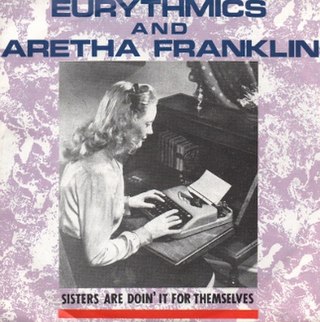
"Sisters Are Doin' It for Themselves" is a song by British pop duo Eurythmics and American singer Aretha Franklin. A modern feminist anthem, it was written by Eurythmics members Annie Lennox and David A. Stewart and featured on both Eurythmics' Be Yourself Tonight (1985) and Franklin's Who's Zoomin' Who? (1985) albums. The duo originally intended to perform with Tina Turner, who was unavailable at the time and so they flew to Detroit and recorded with Franklin instead. The track also features three of Tom Petty's Heartbreakers: Stan Lynch on drums, Benmont Tench on organ, and Mike Campbell on lead guitar, plus session bassist Nathan East.

"Sweet Dreams (Are Made of This)" is a song by British synth-pop duo Eurythmics. It was released as the fourth and final single from their second album of the same name in January 1983. It was their breakthrough hit, establishing the duo worldwide. It reached number two on the UK Singles Chart in March 1983, and number one on the US Billboard Hot 100 six months later; it was their first single released in the US.
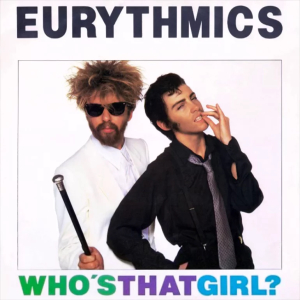
"Who's That Girl?" is a song by British pop duo Eurythmics, released as the lead single from their third studio album, Touch (1983). It was written by band members Annie Lennox and David A. Stewart and produced by Stewart.
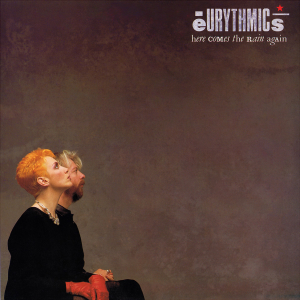
"Here Comes the Rain Again" is a 1983 song by British duo Eurythmics and the opening track from their third studio album Touch. It was written by group members Annie Lennox and David A. Stewart and produced by Stewart. The song was released on 12 January 1984 as the album's third single in the UK and in the United States as the first single.
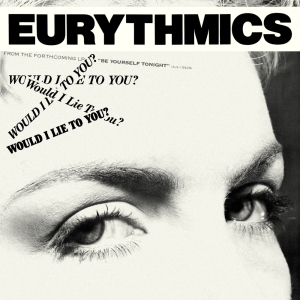
"Would I Lie to You?" is a song written and performed by British pop duo Eurythmics. Released on 9 April 1985 as the lead single from the band's fourth studio album, Be Yourself Tonight (1985), the song was the first by the duo to feature their change in musical direction from a predominantly synthpop style to rock and rhythm and blues. The song, and its accompanying album, featured a full backing band and relied less on electronic programming.
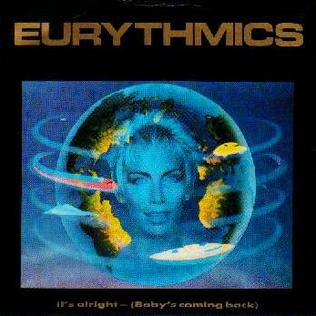
"It's Alright (Baby's Coming Back)" is a song written and recorded by the British pop music duo Eurythmics. It was released as the fourth and final single from their 1985 album Be Yourself Tonight. The song was produced by Dave Stewart, and the song's brass arrangement was devised by Michael Kamen.

"Thorn in My Side" is a song by British pop music duo Eurythmics. It was released as the second single from the duo's fifth studio album, Revenge (1986). Written by band members Annie Lennox and David A. Stewart, the song is a cast-off to an unfaithful lover. "Thorn in My Side" was produced by Stewart.

"I Need a Man" is a song recorded by British pop music duo Eurythmics. It was written by band members Annie Lennox and David A. Stewart and produced by Stewart. Taken from their sixth album, Savage (1987), the song was released in May 1988 by RCA Records as the third single in the UK and the first single in the United States.

"Don't Ask Me Why" is a song recorded by British pop music duo Eurythmics, released as the second single from their seventh album, We Too Are One (1989). The song was written by bandmembers Annie Lennox and David A. Stewart and produced by Stewart with Jimmy Iovine. In the US, it was released as the first single from the album. It is a lush pop song with melancholy and bitter lyrics which describe the ending of a love relationship. In it Lennox tells the subject "don't ask me why / I don't love you any more / I don't think I ever did".

"Precious" is a song by Scottish singer and songwriter Annie Lennox, released on 25 May 1992 as the second single from her debut solo album, Diva (1992). It peaked at number 23 in the UK and was a top 10 hit in Italy. The B-side, "Step by Step", was later covered by Whitney Houston for the soundtrack of her 1996 film, The Preacher's Wife, and became a top 10 hit. "Precious" is unrelated to the B-side track of the same name on the single "Revival" by Eurythmics.
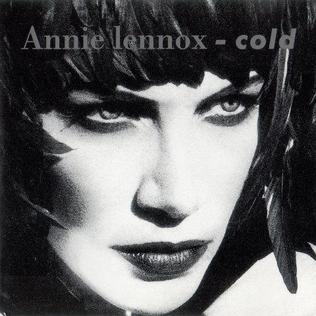
"Cold" is a song by Scottish singer-songwriter Annie Lennox. It was released as the fourth single from her first solo album, Diva (1992), and reached no. 26 in the UK. The single was released as a series of three separate CD singles, titled Cold, Colder and Coldest. Each CD featured the track "Cold" as well as a collection of live tracks. It was the first single to chart in the UK Top 40 without being released on vinyl. A cassette version was also available featuring the lead track and one live track from each CD.

"No More 'I Love You's'" is a song written by British musicians David Freeman and Joseph Hughes and recorded by them as the Lover Speaks. It was released in June 1986 as the lead single from their self-titled debut album. The song was covered by the Scottish singer Annie Lennox and became a commercial success for her in 1995, reaching number two on the UK Singles Chart.

"Little Bird" is a song composed and recorded by Scottish singer-songwriter Annie Lennox. Taken from her debut solo album, Diva (1992), it was released in 1993 as a double A-side with "Love Song for a Vampire" in Ireland, the United Kingdom, and various other European countries. In other territories, "Little Bird" was released alone.

This article is the discography of the Scottish pop and rock singer-songwriter Annie Lennox. After a decade of major international success as part of Eurythmics, Lennox began her solo career in earnest in 1992 with the release of her first album Diva, which produced several hit singles including "Why" and "Walking on Broken Glass". The same year, she performed "Love Song for a Vampire" for Bram Stoker's Dracula. To date, she has released six solo studio albums, three of them being covers albums and a compilation album, The Annie Lennox Collection (2009).





















